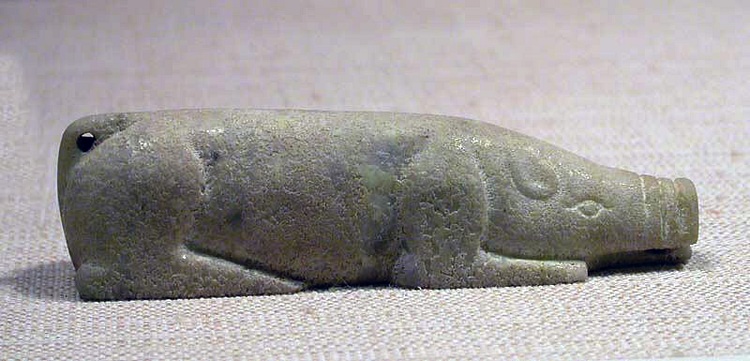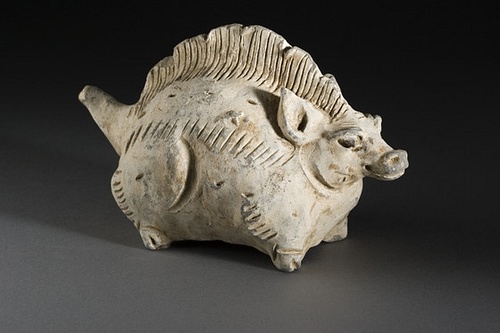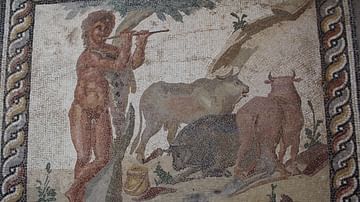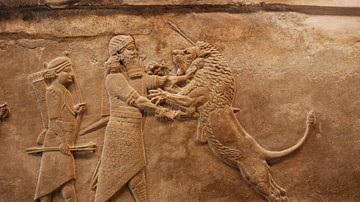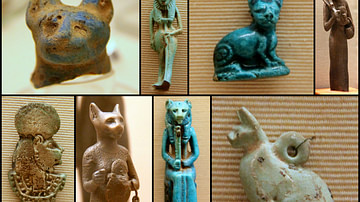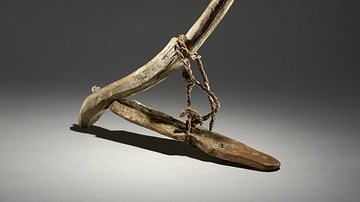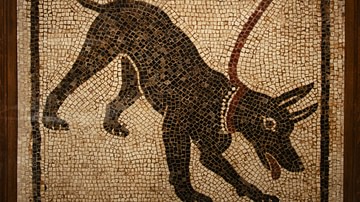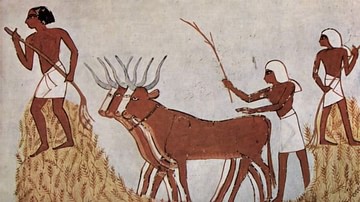Pigs (sometimes called “suids” of the suidae family) have long played an important part in Chinese culture. Pigs symbolize good fortune and happiness as they seem to live a care-free existence and have a long relationship with the humans who have seen them this way.
A 2010 CE study, in fact, found that modern-day pigs in China are the direct descendants of the first pigs domesticated thousands of years ago. The pig is the earliest domesticated animal in China, after the dog, and Neolithic graves have been found to contain pig skulls and ornaments thought to symbolize both the wealth of the deceased and continuing good luck.
The long relationship between the people of China and the pig is evidenced not only by grave goods and other artifacts but by the number of tales from Chinese folklore featuring the pig as well as its place as the 12th animal of the Chinese zodiac. The pig is so important in Chinese culture, in fact, that it features in the pictograph for “home” as noted by scholar Charles Benn:
The word for “home” in Chinese is a pictograph of a roof with a pig beneath. The roof was, of course, essential to any dwelling built above ground. A pig in an abode, however, was peculiar to China. Throughout most of China's history, even in the twentieth century, the pig has been the most prized source of meat, butchered and eaten on ceremonial or sacrificial occasions by even the most humble people. For that reason, the lowly peasant made every effort to protect the creature from theft and allocated space for it within his house. (71)
Pigs were not only used for their meat, however, but also were a part of ritual sacrifice to the gods and symbols of personal wealth and success. From the wealthiest noble or merchant to the humblest peasant, the pig stands out as a unifying force in Chinese culture and an integral aspect of Chinese social and economic interactions.
Early History
Pigs were domesticated in China 10,000 years ago. Many scholars claim the first evidence of domesticated pigs comes from the Zengpiyan site in Gulin City, Guangxi Province which substantiates the date of 10,000 years ago for domestication. Scholars Yuan and Rowan, among others, claim that finds at Cishan, Wu'an County, Hebei Province are more reliable, placing the date at 8,000 years ago, but still do not rule out the possibility of the earlier date.
According to Yuan and Rowan, four conditions needed to be present for the domestication of the pig:
- The need for meat which could not be met by hunting
- Wild pigs living in proximity to human settlements
- The cultivation of wild cereals which encouraged the domestication of pigs
- Surplus cereals which provided food for the pigs without affecting people
In a hunter-gatherer society, food came from whatever could be hunted or found in the region and hunting continued as an important source of food after communities became sedentary. A lack of wild game encouraged people to look for an alternate source for meat. This source was found in wild pigs living nearby whose new-borns could be taken and raised as domestic animals. This new food source could only have been viable, however, if the community could feed the pigs without inconveniencing themselves; so agricultural developments must have been successful enough to provide for this.
An example of this kind of development is clearly seen at Banpo Village in Shaanxi Province, a Neolithic site inhabited between c. 4500-3750 BCE. Based on the physical evidence from excavation, the people had been hunter-gatherers who then adopted an agrarian lifestyle but continued to supplement their diet through hunting. They kept both dogs and pigs, however, as a food source most likely because hunting alone could not meet the community's needs. Pig bones have been found in graves as well as elsewhere in the village, attesting to the importance of the animal. Scholar Seung-og Kim comments:
Pig domestication in China has a long history. Pigs were the predominant domesticated animal in the Neolithic as they are today. More important, it is safe to say that almost all the terrestrial animals involved in Neolithic funerary practices were pigs. Further, Chinese archaeologists have found many pig bone ornaments and figurines. The interment of pig skulls in the Chinese Neolithic was closely linked to the interaction between nutrition, ritual, wealth, and political prestige. (119)
Among the ornaments and figurines Seung-og Kim references is the enigmatic Pig-Dragon (known as the Zhulong), a jade piece from the Hongshan Culture (4700-2900 BCE) of a figure with the face and snout of a pig but body of a serpent. Scholars have traced the evolution of the Pig-Dragon figure to the far more famous Chinese dragon (Wei, et.al, 5). They believe the symbol steadily evolved from the Hongshan until it was fully developed as the dragon by the time of the Zhou Dynasty (1046-256 BCE). Early evidence of the Pig-Dragon appears on ceramic shards found at Banpo but there is other evidence of the importance of pigs to the village in that it may have actually been designed with the pigs in mind.
Banpo Village was enclosed by a ditch which most likely served both as protection and for drainage. Scholars such as Judith M. Treistman, however, believe the “moat” around the village also served as a kind of “invisible fence” which kept the pigs from wandering off. Treistman notes these ditches at a number of Neolithic sites as well as the practice of purposefully constructing homes with the welfare of pigs in mind. She cites the village of Hai Men K'ou in Chien Ch'uan as an example where houses were built on piles to elevate them and protect from flood damage but also “as a shelter for the family pigs” (125).
The family pig was a staple of the Chinese diet which also consisted mainly of vegetables, fish, chicken, game, and dog. A family that could own a pig was considered successful and eating a pig was usually reserved for special events. A story about the philosopher Zengzi (505-435 BCE) illustrates this.
Zengzi, a disciple of Confucius (551-479 BCE), was famous for never telling a lie and for encouraging others to live moral, upright lives. One day, when his wife was going to market, their son ran crying after her. To placate the boy and get him to return home, the wife told her son that she would make him a special dinner of their best pig if only he would behave himself and the child then returned to the house. Zengzi overheard this, slaughtered their best pig, and prepared it for dinner. When his wife returned, she was shocked and asked why he would waste a pig like this when she was only trying to get the boy to be quiet. Zengzi pointed out that, had she not kept her word, the boy would not believe anything else she said and how, if one makes a promise, one must keep it; otherwise words are empty.
Pigs in Folklore
The pig features prominently in folktales which, like this one concerning Zengzi, have a moral. In the story of The Mule and the Lion, a mule is fooled by a lion into traveling with him to visit his “good friend” the pig. The Lion is only interested in eating the pig and wants the mule along to lure the pig from his home. The mule must first ask permission from his mother, who does not want him out after dark, and she reluctantly gives it on the condition that he not go far. The mule ignores his mother's wishes and follows where the lion leads.
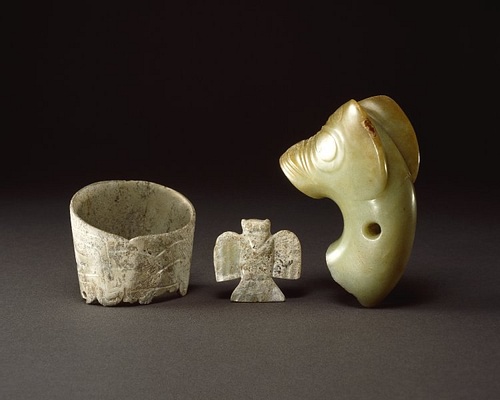
When they reach the pig's home, the lion encourages the mule to go ahead and invite the pig out to talk. The pig, however, listens to his mother who does not want him out after dark either, and refuses the mule's invitation. The lion and the mule are shortly after caught in a hunter's net and, when the mule begs for mercy because he is only a mule and a friend to men, the hunter responds that one is known by the company one keeps and so the mule will be sold at market along with his lion friend.
The pig is also central to the story The Heaven-Sent Pig in which a poor farmer and his wife save up their money and buy a small pig, believing that it will bring them good fortune. The pig does not grow no matter how much they feed it and, year after year, this frustration continues until the wife tells the farmer to stop feeding it because it is a waste of time. The farmer is fond of his little pig, however, and keeps sneaking it food.
One night a stranger comes past as the farmer is out feeding the pig and offers to buy it. The farmer is honest with the stranger and tells him that it is a small pig of little worth. The wife overhears this and runs out to tell him to sell the pig for a high price. The stranger offers 500 silver pieces but the wife wants more and so he offers 1,000 and she sells but, before the transaction is complete, the stranger asks her to vow to heaven that her words are true regarding how she feels about the pig and that she will not go back on the deal. The farmer and his wife both swear and the stranger takes the pig but the wife wants to know why he wants it so badly.
The stranger tells her that inside the pig are two candlesticks which, when removed and lighted, call to their owner all the treasure in the world. He is still speaking when the wife throws his money back at him and runs into the house with the pig. She slaughters it, takes out the candlesticks, and lights them. Suddenly all the treasures in the world begin to swirl above her but, each time she tries to grab one, it slips away. Finally, the candles burn down and she is left alone in the darkness with nothing.
Months later the stranger returns and the farmer and his wife are now in worse shape than before. The wife accuses the stranger of lying to them but the stranger points out that she grabbed the pig and ran into the house while he was still speaking and that he never got the chance to tell her she would need to throw rice at the objects and repeat her true vow to heaven to get anything. The moral of the story, as the farmer then observes, is that greed destroys everything.
The pig is not always featured positively, however. Pigs also symbolized sloth, self-indulgence, intemperance, and lack of any kind of self-control. The most famous example of the pig in this role comes from the 16th century CE Chinese novel Journey to the West in which the character of Zhu Bajie symbolizes the worst aspects of the pig; his name, “Zhu”, even means “swine”.
Scholar Edward T.C. Werner notes that Zhu, the “pig fairy”, stands for “the coarser passions, which are constantly at war with the conscience in their endeavors to cast off all restraint” (326). Zhu is originally an honored member of the host of heaven but tries to seduce the moon goddess and is cast down to earth. He is finally condemned to clean the altars to the gods by eating the leftover offerings from around them like a pig.
The Pig in the Zodiac
These more negative aspects of the pig play a part in the two best-known stories of how the pig becomes part of the Chinese zodiac. In the first story, a young boy is born to an affluent family and is told that he is blessed and will have a good life. He interprets this to mean he can just enjoy himself and so commits to no course of study and never does any work. Eventually, his parents die and, since he has mastered no craft, he can no longer pay the servants or keep his house and loses everything. He still believes he is blessed and everything will turn around for him and so continues doing as he always has until he dies.
He appears before the King of the Underworld and complains that this was not his fate. He was told he was blessed, he says, and his life should have turned out differently. The King of the Underworld brings him before the Jade Emperor for judgment. The Jade Emperor, after hearing his story, becomes enraged and says, “You were given everything but made nothing of it. All your life you have been lazy and self-indulgent so I will turn you into a pig who eats chaff.” At this same time, the Heavenly Court was deciding which animals would make up the signs of the Chinese zodiac and were stuck on the last one. The Jade Emperor orders an officer of his court to transfer the newly-made pig back to earth but the officer misunderstands and places the pig instead in the sky; and so the pig becomes the last sign of the zodiac.
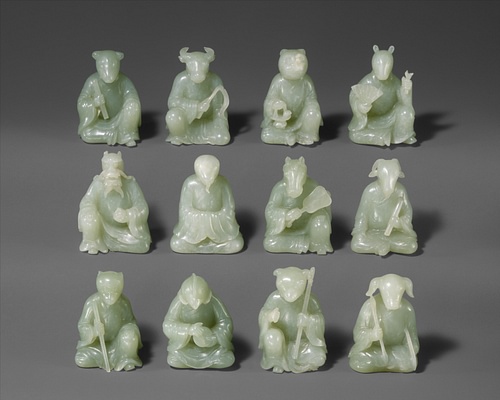
The second, and better known, story is known as The Great Race. The Jade Emperor announces there will be a race among the animals and whichever are the first twelve to cross the finish line will be honored eternally in the night sky. The animals all line up and the race begins with the cat and the rat making a deal to ride together on the back of the ox and leap off at the last minute to be the first to win. On the way, the rat startles the cat who falls off into a river and is washed away; this is why there is no year of the cat and also why cats hate rats to this day.
The animals all come across the finish line in various ways, the rat first and then the ox, tiger, rabbit, dragon, snake, horse, sheep, monkey, rooster, and dog and the Jade Emperor is standing there to welcome and congratulate them. The last to cross the line is the pig and the Jade Emperor is surprised. Considering the pig's speed in running, the Emperor asks, how is it he has come in last. The pig replies that he would have arrived sooner but was hungry along the way and had to stop for snacks and, after eating, he was tired and took a nap. The Jade Emperor recognizes that this is the nature of the pig and welcomes him to the zodiac with the others.
Conclusion
In Chinese astrology, people born under the sign of the pig are optimistic, self-indulgent, exciting, materialistic, good-hearted and warm, and fun to have as company. The pig is associated with the earth and so those born under its sign are also stable and grounded and, in terms of the Yin-Yang dichotomy, are yin and most productive at night between the hours of 9-11(21:00-23:00). Like their sign, these people are also said to be lucky and enjoy good fortune.
The pig continues to feature prominently in many rituals and ceremonies in China having to do with good luck – although these events are not in any way lucky for the pig. A popular dish served not only at festivals but year-round is the siu-yuk (“roast meat”), a whole pig roasted over a charcoal fire (or in a furnace). The Shen-Dzu (“Holy Pig”) is a pig purposefully fattened to its greatest weight who is then entered into contests at the New Year's celebration. The winner is sacrificed to a local deity (or the spirit of the city) and eaten and then the runners-up meet the same end.
The celebration known as the manyue – honoring the first 30 days of someone's life (their first “birthday”) involves presenting guests with pig's feet among the other party favors as a symbol of good luck and gratitude. The inclusion of the pig in these parties is hardly surprising since pigs have played an important part in Chinese rituals now for thousands of years. From Neolithic times to the present, the pig has remained a constant and iconic figure in Chinese culture and in 2019, the present Year of the Pig, will no doubt be featured prominently in many celebrations.
